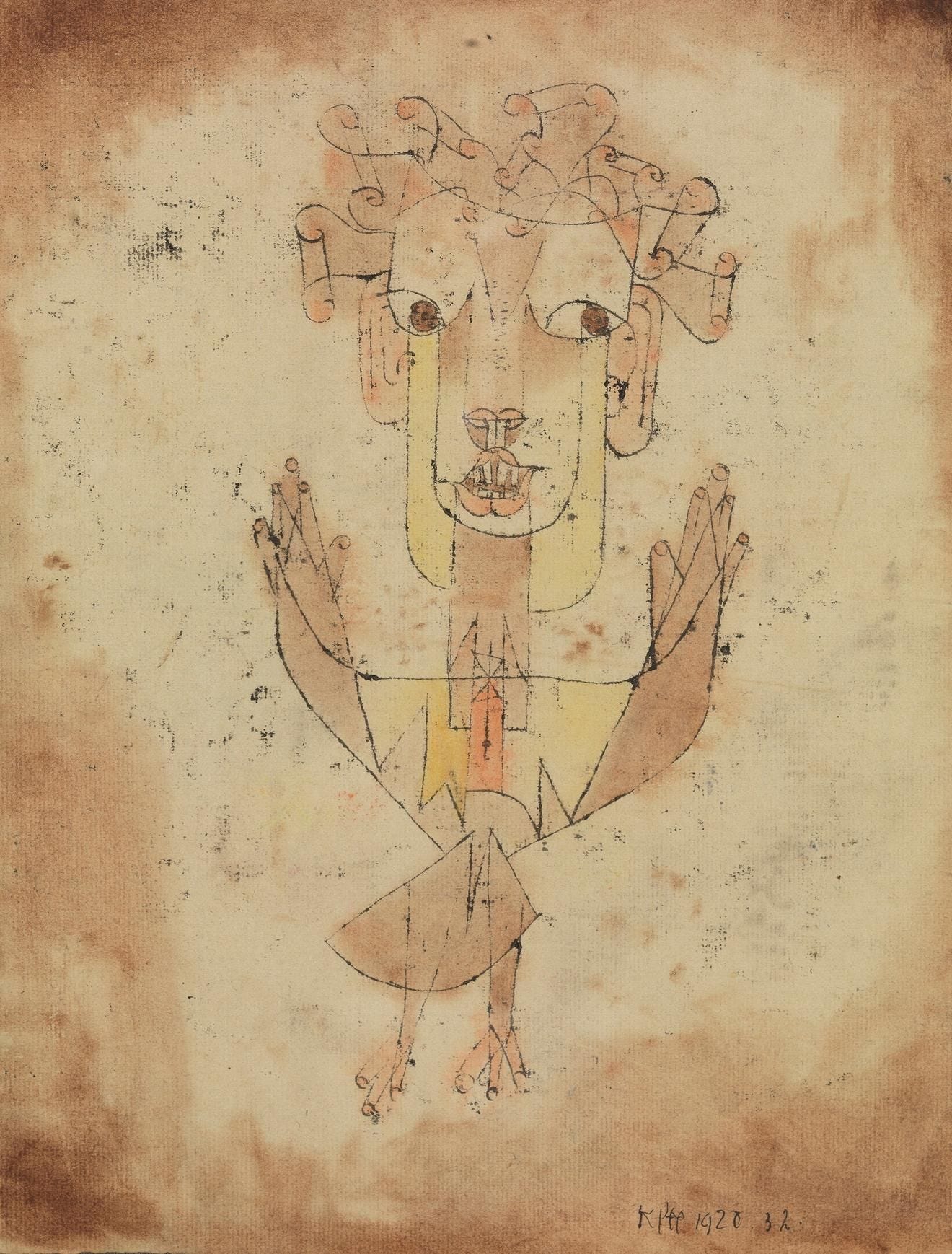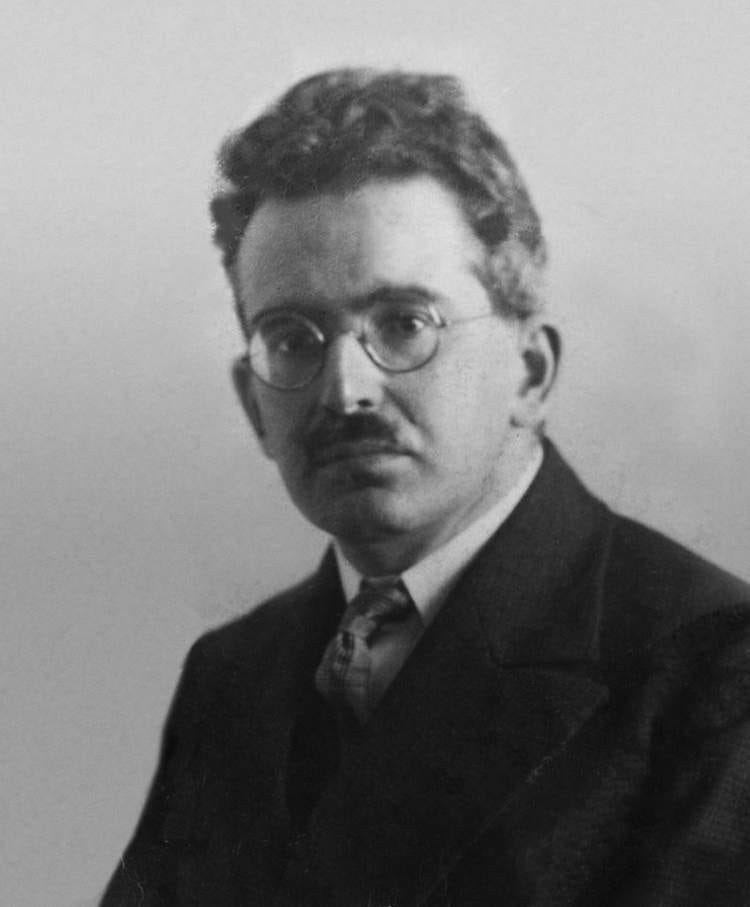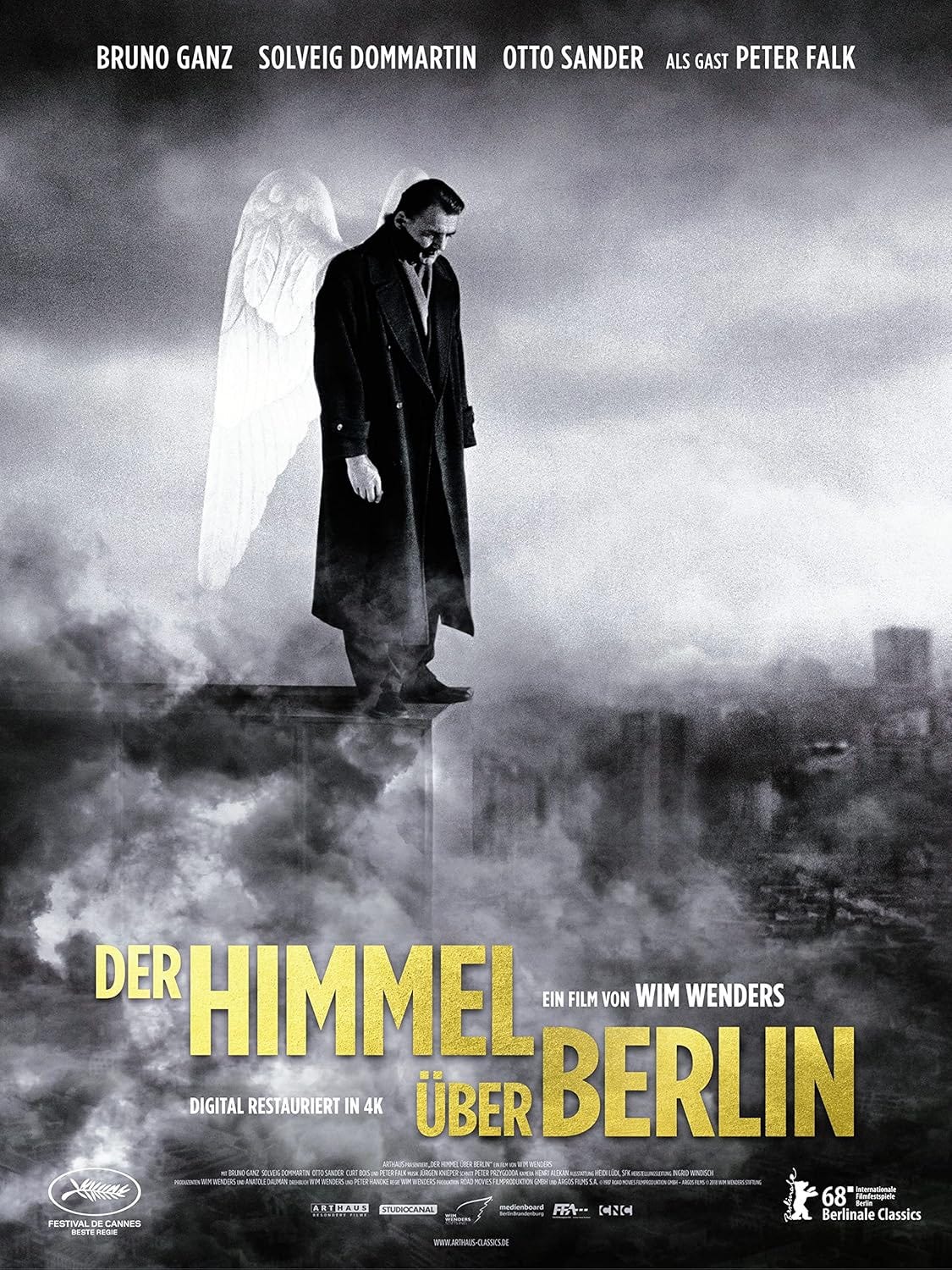The Angel of History in Berlin
Paul Klee's Angelus Novus—Walter Benjamin's Angel of History—is more than a painting: it's a catalyst of meaning and a warning. In Berlin, 2025, it still asks if we're ready to learn from the past.
An angel has returned to Berlin—a strange, unsettling angel, full of meaning. It left the city with its owner, the philosopher Walter Benjamin, when he was forced into exile in 1933. Now it’s back, on display at the Bode Museum for just two months, until July 2025.
The return feels almost like a miracle. Paul Klee’s Angelus Novus is a small, fragile piece—an oil transfer drawing on watercolor. It’s just a little bigger than a sheet of A4 paper, barely 30 by 25 centimeters. A scrap of paper that somehow survived escape, exile, and war. Since the 1980s, this delicate work has lived in Jerusalem, part of the Israel Museum’s collection. Because it’s so fragile, it almost never travels. That it’s here now is extraordinary.
But its presence in Berlin carries a heavy, unsettling weight—especially for those who know what it means, and how Benjamin saw it.

Angelus Novus is an abstract figure—with large, childlike eyes and small wings, half-open or maybe bent by the wind. The teeth are sharp. The eyes droop. Its hair curls in loops that almost look like the scrolls of the Torah.
The angel stares outward, as if watching something we can’t see. Behind it, the watercolor background swirls like a storm. In the angel’s torso, some even see a pendulum—hinting at time.
Is it moving forward? Backward? Or just caught in the storm, suspended in between? It’s hard to say. What is it looking at, with those wide, solemn eyes? How many symbols did Paul Klee, drawn to the mysticism of the Kabbalah, embed in this strange little figure? And how many more did Walter Benjamin see? Or his friend Gershom Scholem—the foremost scholar of Jewish mysticism—who would later inherit the painting?
If this small, cryptic painting still sparks so much study and wonder, it’s largely because Benjamin gave it meaning—deeply personal, and historical. He bought it in 1921 at an exhibition in Munich, and never let it go. He didn’t hang it like a decoration. He kept it close, as if it were a companion. A muse. Maybe even a mirror.
Benjamin was wrestling with the meaning of History. And at that moment, history had nothing hopeful to offer. Not even for the future.
Angelus Novus at home with Walter Benjamin and in exile.
Paul Klee painted Angelus Novus in 1920—a turning point in his career. That year saw his first major exhibition in Munich and his connection with the newly founded Bauhaus school. These were turbulent postwar times. Germany was in ruins. Artists, like philosophers, searched for new meaning. Many turned to mysticism.
Klee responded with an art that, in his own words, “does not reproduce the visible, but makes visible” what lies beneath. Each line, each color, was a symbol, a metaphor, an allegory. His works reflected a metaphysical understanding of the world.
When Angelus Novus appeared in that first major exhibition, it seemed almost fated to cross paths with Walter Benjamin. At the time, Benjamin’s life was unsettled. His marriage was unhappy, and financially he still relied on his parents. But when he saw the painting, he couldn’t turn away. He knew he had to buy it.
What did he see in it? A reflection of himself—trapped between past and future, caught in a storm? His melancholy? His deepening pessimism? Or maybe the mirror of a world emerging from one catastrophe only to march toward another?
He purchased the painting in 1921 for one thousand Marks, just before inflation destroyed the value of German currency. For a time, he left it in the Munich apartment of his friend Gershom Scholem, who was then immersed in the study of angelic hymns in Jewish mysticism. Later, Benjamin brought the painting to Berlin, hung it in his study, and kept it close wherever he moved.
From the wall, the angel entered his thoughts and dreams. Again and again, he returned to it, finding in its lines and expression echoes of his own life.
When he was forced into exile in 1933, he took the painting with him to Ibiza. There, he wrote a meditative autobiographical text—Agesilaus Santander—in which he poured out his emotional bond with the angel.
To Benjamin, the angel symbolized everything he had been forced to leave behind: people, memories, objects, even parts of himself.
The very title Agesilaus Santander was a cryptic wordplay—an anagram of Der Angelus Satanas, the Satanic Angel. It was a secret name he gave himself, filled with irony and mysticism. Benjamin believed in angels. But he also saw their darker side. Their power was not only to guide or guard—but to see. To witness both past and future.
An idea was taking shape at the tip of his pen—not yet fully formed, but powerful: this divine, ambiguous angel might be a metaphor for History itself.
The Angel of History
From Ibiza, Walter Benjamin reached Paris in 1933. At first, it seemed a haven: vibrant, artistic, perhaps a place to heal. But it was not. In June 1940, the Nazis reached Paris. Benjamin fled. He packed his manuscripts into two suitcases, cut Angelus Novus from its frame, and added it to the bundle. He entrusted everything to Georges Bataille, who secretly safeguarded the painting at the Bibliothèque Nationale until the liberation.
From there, Benjamin continued south, reaching Marseille and then the Pyrenees. In a Spanish border town in September 1940, upon hearing he might be handed back to the Nazis, he took his own life with an overdose of morphine tablets.
His final philosophical work was written in those last months and entrusted to another friend: in September 1940, he handed the manuscript of Thesen über den Begriff der Geschichte (On the Concept of History) to Hannah Arendt in Marseille. She managed to escape to the United States, where the theses were later published.
In this collection of 18 short theses, Benjamin reimagines how we should think about history. He rejects the notion of constant progress—the belief that everything is steadily improving. Instead, he sees history as a series of catastrophes, misunderstood or concealed by those who write it—often the victors.
And here, again and finally, appears Angelus Novus. In the ninth thesis, Benjamin transforms Klee’s figure into the “Angel of History”—an angel looking back on the wreckage of the past, powerless to intervene, yet full of yearning to heal what has been broken:
“There is a painting by Klee called Angelus Novus. An angel is depicted who looks as if he were about to move away from something he is staring at. His eyes are wide open, his mouth stands open, and his wings are spread. The Angel of History must look like this. His face is turned toward the past. Where we see a chain of events, he sees one single catastrophe that keeps piling wreckage upon wreckage and hurls it at his feet. He would like to stay, awaken the dead, and make whole what has been smashed. But a storm is blowing from Paradise; it has got caught in his wings with such violence that the angel can no longer close them. This storm irresistibly propels him into the future to which his back is turned, while the pile of debris before him grows skyward. This storm is what we call progress.”
– Walter Benjamin, Thesis IX, On the Concept of History (1940)1
The Angel is helpless, his wings caught by the storm. He cannot stop or turn around. The storm—the very force we call “progress”—drives him forward into a future he cannot see, while the wreckage of the past rises before him, untouched.
What awaits the Angel—and humanity—is another catastrophe. Unless…
Unless a shock tears through the seamless fabric of historical time. A rupture that allows us to see forgotten and suppressed possibilities. Benjamin calls this a messianic moment—and it can occur at any time. Even in the darkest hour, a “messianic spark” can change history’s course.
But this requires that we truly see the past—not as a march of triumphs, but as a graveyard of missed chances, suffering, and longing. From that remembrance—not celebration, but mourning—can arise the energy for revolutionary change.
This is what Benjamin calls the Messiah: not a figure, but a collective awakening. A recognition, after surveying the landscape of ruins, of what must be done.
“Every second [is] the small gateway through which the Messiah might enter.” – Walter Benjamin, On the Concept of History
Yesterday, today.
Western Europe experienced its messianic moment in the aftermath of the Second World War. Out of the ruins, it chose not to return to the old order of warring nations, but instead to build a cooperative project—what we now call the European Union. A project of peace. This “pathetic” Europe, as some sneer—one that many, from both outside and inside, now seek to dismantle. May 9, 1950 (Schuman Declaration) marked the beginning of a new era. But history is not linear. And progress, as Walter Benjamin reminds us, is a deeply ambiguous concept.
Today, in Berlin, the Angel of History looks upon different ruins, caught in yet another storm sweeping across our continent. It reminds us that every catastrophe can lead to the next—unless we find the strength to look back, truly remember, and transform that memory into messianic energy.
There is still time.
And perhaps it is no coincidence that Angelus Novus, the Angel of History, is here with us, in Berlin, in this spring of 2025.
The Angel of History. Walter Benjamin, Paul Klee and the Berlin Angels 80 Years After WWII
08.05.2025 to 13.07.2025 at the Bode-Museum, Berlin
P.S. At the Bode Museum, Angelus Novus is surrounded by other angels from Berlin’s collections. But most of the city’s angels are not kept behind glass. Berlin is, in fact, a city of angels scattered across its streets: in the quiet Protestant cemeteries, on church façades, on fountains—and of course, the unforgettable angel from the big screen, who has been watching over Berlin since 1987.
Sources and deep dives
2006 / Baetschmann / “Angelus Novus und Engel der Geschichte: Paul Klee und Walter Benjamin” / ArtDok, Universität Heidelberg / (GERMAN)
October 19, 2020 / “Angelus Novus’ Eyesight: On Benjamin’s Aesthetic Mysticism” / Blue Labyrinths / (ENGLISH)
May 11, 2025 / “Als Walter Benjamin den „Engel der Geschichte“ fand” / Die Tagespost / (GERMAN)
May 15, 2025 / “Stories of Iconic Artworks: Paul Klee’s Angelus Novus” / Artland Magazine / (ENGLISH)
May 15, 2025 / “Angelus Novus - Wikipedia” / Wikipedia / (ENGLISH)
May 15, 2025 / “Did Walter Benjamin understand his prize possession — Paul Klee’s Angelus Novus?” / The Forward / (ENGLISH)
May 15, 2025 / “Angel of Mystery” / Commonweal Magazine / (ENGLISH
May 15, 2025 / Walter Benjamin / “On the Concept of History / Theses on the Philosophy of History” / Simon Fraser University (sfu.ca) / (ENGLISH)
May 15, 2025 / “The Storm Blowing from Paradise: Walter Benjamin and Klee’s Angelus Novus” / Verso Books Blog / (ENGLISH)
2017 / Walter Benjamin / “Über den Begriff der Geschichte” / Burg Giebichenstein Kunsthochschule Halle (PDF) / (GERMAN)
May 15, 2025 / “Walter Benjamin und die Geschichte” / Philosophie Magazin / (GERMAN)
May 15, 2025 / “Über den Begriff der Geschichte – Wikipedia” / (GERMAN)
»Es gibt ein Bild von Klee, das Angelus Novus heißt. Ein Engel ist darauf dargestellt, der aussieht, als wäre er im Begriff, sich von etwas zu entfernen, worauf er starrt. Seine Augen sind aufgerissen, sein Mund steht offen und seine Flügel sind ausgespannt. Der Engel der Geschichte muß so aussehen. Er hat das Antlitz der Vergangenheit zugewendet. Wo eine Kette von Begebenheiten vor uns erscheint, da sieht er eine einzige Katastrophe, die unablässig Trümmer auf Trümmer häuft und sie ihm vor die Füße schleudert. Er möchte wohl verweilen, die Toten wecken und das Zerschlagene zusammenfügen. Aber ein Sturm weht vom Paradiese her, der sich in seinen Flügeln verfangen hat und so stark ist, daß der Engel sie nicht mehr schließen kann. Dieser Sturm treibt ihn unaufhaltsam in die Zukunft, der er den Rücken kehrt, während der Trümmerhaufen vor ihm zum Himmel wächst. Das, was wir den Fortschritt nennen, ist dieser Sturm.« – Walter Benjamin: Über den Begriff der Geschichte (1940), These IX






